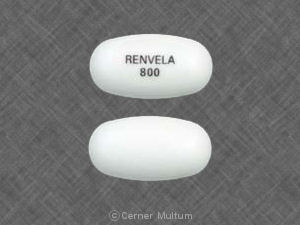Renvela and Alcohol/Food Interactions
There are 2 alcohol/food/lifestyle interactions with Renvela (sevelamer).
Multivitamins With Minerals Sevelamer
Moderate Drug Interaction
ADJUST DOSING INTERVAL: Bile acid sequestrants and the phosphate binder, sevelamer, can decrease the absorption of fat-soluble vitamins A, D, E, and K. By binding bile acids, these agents may interfere with normal fat digestion and absorption, thereby preventing the absorption of fat-soluble vitamins. When 8 grams of cholestyramine was administered simultaneously with a normal meal containing 250,000 units of vitamin A acetate in four healthy young adult subjects, plasma vitamin A levels were significantly reduced during a 9-hour postprandial period compared to the values obtained with the control meal. Coadministration with 4 grams of cholestyramine had no significant effect. In a crossover study involving healthy subjects, coadministration of sevelamer with calcitriol resulted in a significant reduction in bioavailability for calcitriol (calcitriol with sevelamer vs calcitriol alone: AUC 137 pg*h/mL vs 318 pg*h/mL and Cmax 40.1 pg/mL vs 49.7 pg/mL, respectively). Chronic use of bile acid sequestrants has been rarely associated with an increased bleeding tendency due to hypoprothrombinemia resulting from vitamin K deficiency. Isolated cases of Vitamin A (including one case of night blindness) and D deficiencies have also been reported with chronic cholestyramine therapy.
MANAGEMENT: When bile acid sequestrants are given for prolonged periods, some manufacturers recommend that concomitant supplementation with water-miscible or parenteral forms of fat-soluble vitamins be considered. If oral vitamin supplements are used with cholestyramine or colestipol, advise patients to take them at least 1 hour before or 4 to 6 hours after the bile acid sequestrant to minimize the potential impact on their absorption. No recommendations are available for sevelamer, but it may be advisable to follow the same precautions.
References (11)
- Gross L, Brotman M (1970) "Hypoprothrombinemia and hemorrhage associated with cholestyramine therapy." Ann Intern Med, 72, p. 95-6
- Shojania AM, Grewar D (1986) "Hypoprothrombinemic hemorrhage due to cholestyramine therapy." Can Med Assoc J, 134, p. 609-10
- Longstreth GF, Newcomer AD (1975) "Drug-induced malabsorption." Mayo Clin Proc, 50, p. 284-93
- Acuna R, Gonzalez Ceron M (1977) "Hypoprothrombinemia and bleeding associated to treatment with cholestyramine (author's transl)." Rev Med Chil, 105, p. 27-8
- (2001) "Product Information. Rocaltrol (calcitriol)." Roche Laboratories
- (2001) "Product Information. Welchol (colesevelam)." Daiichi Sankyo, Inc.
- (2005) "Product Information. Fosamax Plus D (alendronate-cholecalciferol)." Merck & Co., Inc
- Cerner Multum, Inc. "UK Summary of Product Characteristics."
- Cerner Multum, Inc. "Australian Product Information."
- Peirce D, Hossack S, Poole L, et al. (2011) "The effect of sevelamer carbonate and lanthanum carbonate on the pharmacokinetics of oral calcitriol." Nephrol Dial Transplant, 26, p. 1615-21
- Vroonhof K, van Rijn HJM, van Hattum J (2003) "Vitamin K deficiency and bleeding after long-term use of cholestyramine." Neth J Med, 61, p. 19-21
Sevelamer Food/Lifestyle
Moderate Food Interaction
ADJUST DOSING INTERVAL: Sevelamer may decrease the oral bioavailability of concomitantly administered drugs. While clinical data are lacking for most drugs, the intestinal absorption of some may be impaired due to sevelamer's binding capabilities.
MANAGEMENT: As a precaution, drugs that can be adversely affected by alterations in blood levels should be administered 1 hour before or 3 hours after sevelamer.
References (2)
- (2001) "Product Information. Renagel (sevelamer)." Genzyme Corporation
- (2002) "Product Information. Xatral (alfuzosin)." Sanofi-Synthelabo Canada Inc
Switch to consumer interaction data
Renvela drug interactions
There are 44 drug interactions with Renvela (sevelamer).
Renvela disease interactions
There are 3 disease interactions with Renvela (sevelamer) which include:
More about Renvela (sevelamer)
- Renvela consumer information
- Check interactions
- Compare alternatives
- Pricing & coupons
- Reviews (7)
- Drug images
- Side effects
- Dosage information
- During pregnancy
- Generic availability
- FDA approval history
- Drug class: phosphate binders
- Breastfeeding
- En español
Related treatment guides
Drug Interaction Classification
| Highly clinically significant. Avoid combinations; the risk of the interaction outweighs the benefit. | |
| Moderately clinically significant. Usually avoid combinations; use it only under special circumstances. | |
| Minimally clinically significant. Minimize risk; assess risk and consider an alternative drug, take steps to circumvent the interaction risk and/or institute a monitoring plan. | |
| No interaction information available. |
See also:
Further information
Always consult your healthcare provider to ensure the information displayed on this page applies to your personal circumstances.


